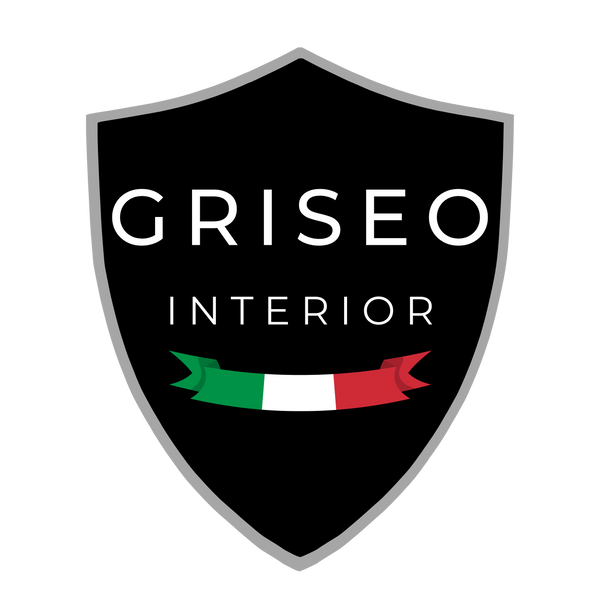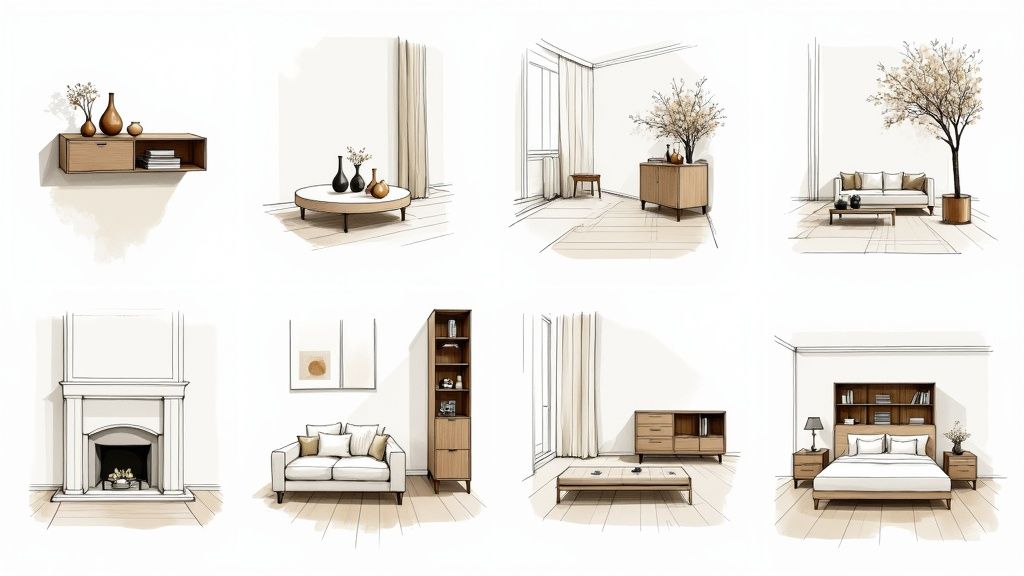
8 Actionable Minimalist Home Decor Ideas for 2025
Minimalism is far more than an aesthetic of empty rooms; it’s a philosophy of intentional living. It’s about creating serene, highly functional spaces where every single object serves a purpose, sparks joy, and tells a part of your story. This approach isn't about deprivation, but about thoughtfully curating a home that has room to breathe, a place where quality always triumphs over quantity and tranquility is the ultimate goal. True minimalism feels personal and warm, not cold or sterile.
This guide moves beyond generic advice to provide actionable minimalist home decor ideas that will help you transform your living space into a genuine sanctuary of calm and style. We will explore how to master foundational principles, from leveraging negative space to embracing natural textures. More importantly, we'll demonstrate how to infuse your space with personality by integrating contemporary Italian accents, like the sculptural, 3D-printed vases from Griseo Interior, to craft a home that is both beautifully simple and deeply personal. Prepare to discover the profound impact of thoughtful, intentional design and create a space that truly supports your well-being.
1. Build a Neutral Color Palette Foundation
A neutral color palette is the bedrock of minimalist design, creating a serene and unified atmosphere that celebrates space, light, and form. This foundational approach swaps bold, distracting colors for a sophisticated spectrum of whites, beiges, grays, and muted earth tones. The goal is not to create a sterile environment, but a tranquil canvas that allows carefully chosen architectural details and decor pieces to truly shine. Embracing this palette is one of the most impactful minimalist home decor ideas for cultivating a peaceful, intentional living space.
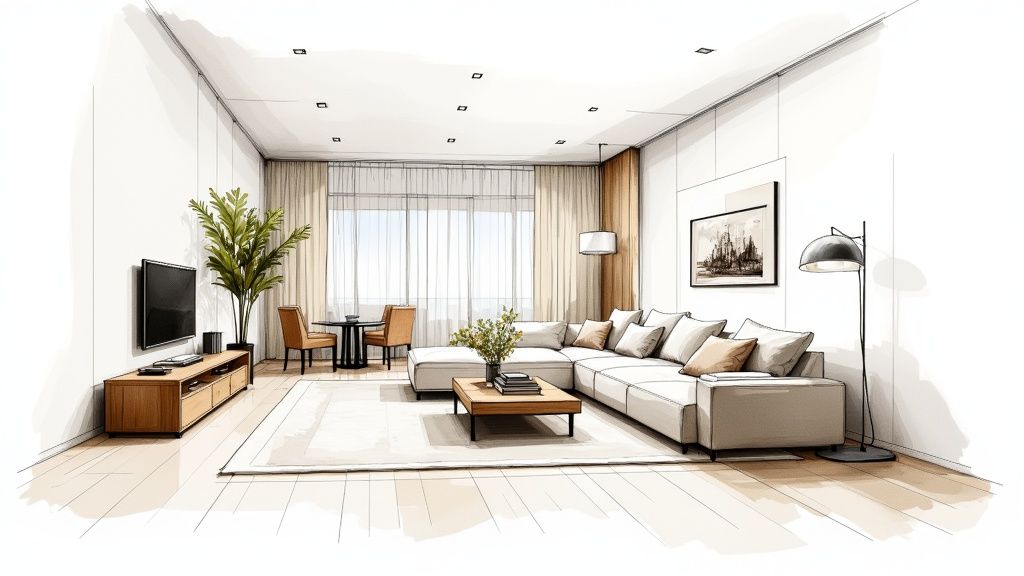
How to Build Your Neutral Palette
Mastering neutrals is about layering shades and textures to create depth and warmth. A common mistake is using a single shade of white or gray, which can make a room feel flat and clinical.
- Select a Dominant Shade: Start with a primary neutral for your walls, like a soft off-white or a light, warm gray. This will set the overall tone of the room.
- Layer with Secondary Hues: Introduce two to three complementary neutral tones through larger furniture pieces like your sofa, area rug, or curtains. Think of a creamy beige sofa against light gray walls.
- Add Tertiary Accents: Use darker or more saturated neutrals for smaller decor items. This is where a piece like Griseo Interior’s Onda Vase in a rich Terra color can add a striking yet harmonious focal point, its sculptural form and earthy tone providing visual interest without disrupting the calm.
Pro Tip: Pay close attention to undertones. A gray with a blue undertone creates a cool, modern feel, while a beige with a pink undertone imparts warmth and softness. Test paint swatches in your space at different times of day to see how the light affects them before committing.
2. Choose Multi-Functional Furniture
Multi-functional furniture is a cornerstone of intelligent minimalist design, embodying the principle of doing more with less. These innovative pieces serve multiple purposes while maintaining the clean, simple lines that define the aesthetic. By maximizing utility, multi-functional furniture eliminates the need for numerous single-use items, reducing clutter and preserving a sense of spaciousness. This approach is one of the most practical minimalist home decor ideas, especially for smaller homes where every square foot is precious.
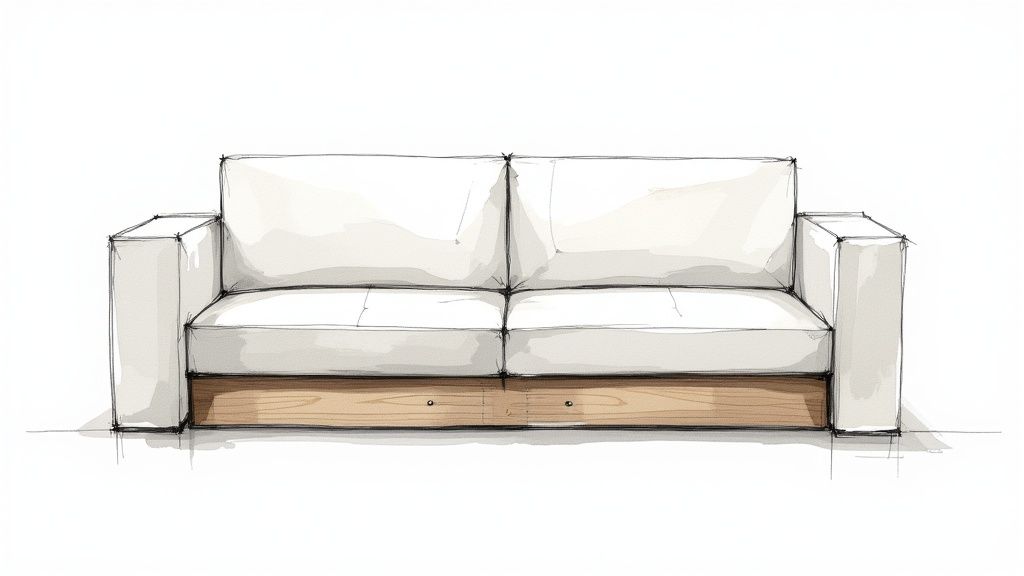
How to Choose Smart, Versatile Pieces
Selecting the right multi-functional furniture is about identifying your specific needs and investing in quality design. Instead of simply buying pieces that look good, focus on items that solve a genuine space or storage challenge.
- Prioritize Problem-Solvers: Identify your biggest pain points. Is it a lack of guest space? A daybed that converts into a full-size bed is ideal. Need more surface area and storage? A coffee table with a lift-top and hidden compartments is a perfect choice.
- Invest in Quality Mechanisms: For pieces that transform, like a wall bed or an extendable dining table, the mechanism is everything. High-quality, durable hardware ensures smooth operation and longevity, making the investment worthwhile.
- Look for Hidden Storage: Some of the best multi-functional designs incorporate discreet storage. Ottomans that open up, benches with built-in drawers, and bed frames with under-mattress storage are excellent for stowing away items while keeping surfaces clear.
Pro Tip: Before purchasing, carefully measure not only the intended space but also all doorways, hallways, and stairwells. A beautiful transforming sofa is useless if you can't get it into the room.
This strategy is particularly effective in compact living areas. For more inspiration on making the most of a limited footprint, you can find more small living room design ideas on griseointerior.com.
3. Use Negative Space Strategically
Negative space, often called white space, is the art of intentional emptiness. In minimalist design, it’s not just what you put into a room, but what you choose to leave out. This approach treats empty areas as an active design element, creating visual breathing room that directs focus to the carefully selected pieces you truly love. Embracing this principle is one of the most transformative minimalist home decor ideas, as it allows each object to have its own presence and importance.
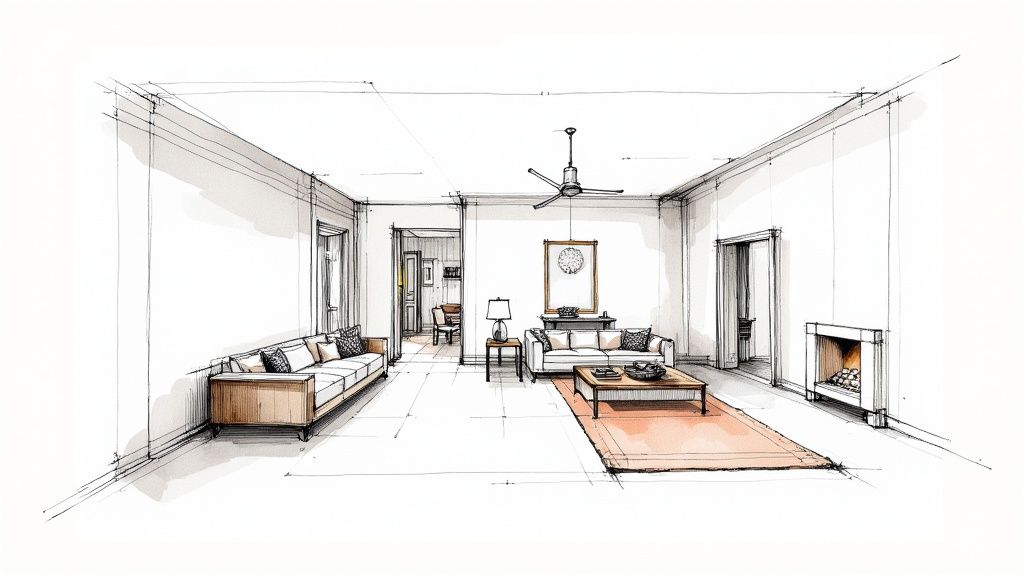
How to Master Negative Space
Creating impactful negative space is about intentional editing and thoughtful placement, not just having less stuff. It’s about achieving a sense of quiet and balance where the eye can rest.
- Edit Your Surfaces: Start today by clearing a major surface, like your coffee table or kitchen counter. Leave only one to three essential or beautiful items. Notice the immediate sense of calm.
- Give Furniture Room to Breathe: Pull your sofa, chairs, and tables a few inches away from the walls. This small shift creates visual separation, making the room feel larger and more considered.
- Create a Singular Focus: Use negative space to frame a special item. Place a single, compelling object like Griseo Interior's Anfora Vase in classic white on an otherwise empty console table. The surrounding emptiness commands attention and elevates its status from accessory to art.
Pro Tip: Think like a gallery curator. Art galleries use expansive wall and floor space to ensure each artwork can be appreciated without distraction. Apply this logic at home by evaluating each piece and asking if it has enough space to make a statement or if it's getting lost in the crowd.
4. Layer with Natural Materials and Textures
Incorporating natural materials is a cornerstone of minimalist home decor ideas, adding essential warmth, depth, and tactile interest to otherwise simple spaces. This approach celebrates the inherent beauty of organic elements like wood, stone, linen, and wool, infusing a room with a sense of calm and connection to the natural world. Instead of relying on color for visual impact, minimalism uses the subtle variations and authentic imperfections of these materials to create a rich, layered, and inviting environment that feels both sophisticated and grounded.
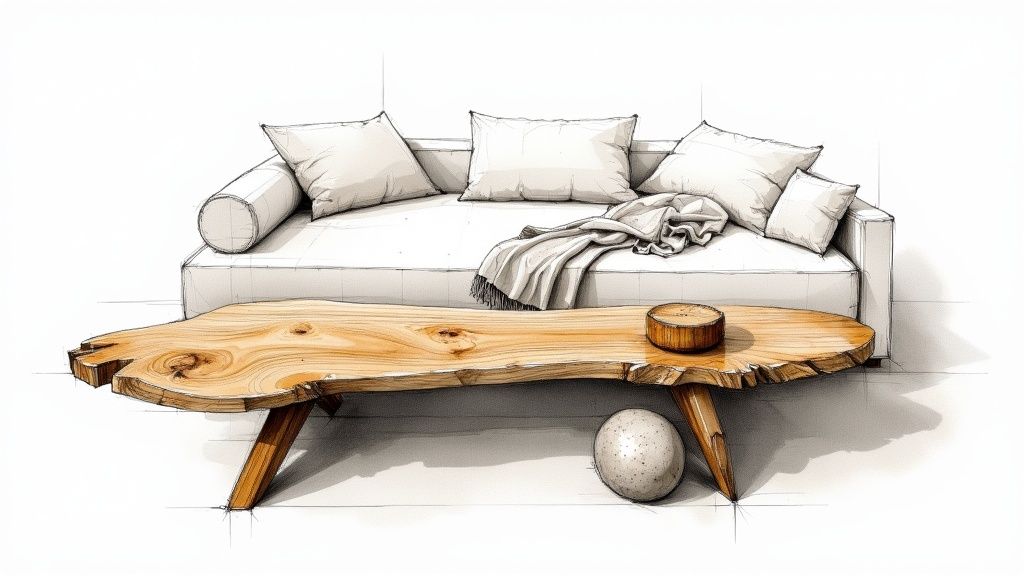
How to Layer Natural Elements
The art of using natural materials lies in thoughtfully mixing textures to build a sensorially rich space without adding visual clutter. The goal is to create harmony through variation.
- Start with a Foundation: Establish a base with larger items. Consider a live-edge wooden dining table, a jute or sisal area rug for texture underfoot, or elegant linen curtains that diffuse light beautifully.
- Introduce Complementary Materials: Layer in contrasting yet harmonious textures. Pair a smooth leather armchair with a chunky wool throw, or place a sleek marble tray on a rustic oak coffee table.
- Incorporate Organic Accents: Small details make a significant impact. Introduce items that showcase raw beauty, such as Griseo Interior’s Onda Vase in its earthy Sand color. Its organic form and textured finish can act as a sculptural piece that embodies the principles of using natural, tactile elements to elevate a space. Exploring eco-friendly home accents can provide further inspiration for sustainable and stylish choices.
Pro Tip: Don't be afraid to mix different types of wood, but keep the undertones consistent. Pairing a light ash wood floor with walnut furniture can work beautifully if both have a warm, neutral undertone. This creates a cohesive look that still feels dynamic and collected over time.
5. Adopt a "Quality Over Quantity" Philosophy
The quality over quantity philosophy is the very soul of minimalist design, shifting the focus from accumulation to appreciation. This approach involves investing in fewer, exceptionally well-made pieces rather than cluttering a space with numerous disposable items. It's about intentional selection, choosing timeless, functional, and beautifully crafted objects that serve a purpose and bring lasting joy. Adopting this mindset is one of the most transformative minimalist home decor ideas, creating a home filled with meaningful items that endure.
How to Embrace Quality Curation
Curating a home based on quality means every item is a deliberate choice. It’s about building a collection of pieces you truly love, like a classic Eames lounge chair or a versatile Saarinen tulip table, that will stand the test of time.
- Prioritize Foundational Pieces: Begin with the most-used items in your home, such as your sofa, bed, or dining table. Investing in a high-quality version of these foundational elements provides an immediate and noticeable upgrade to your daily life.
- Research Timeless Designs: Look for pieces with proven longevity, designs that have remained relevant for decades. Think of classics like the Noguchi coffee table or the Vitsoe 606 Universal Shelving System, which demonstrate that good design is truly timeless.
- Invest in Functional Art: Incorporate items that blend form and function beautifully. For instance, Griseo Interior’s Aura Vase, with its elegant form and durable, eco-friendly material, serves as a sculptural accent while being a functional vessel, perfectly embodying the principle of fewer, better things.
Pro Tip: Shift your perspective from initial cost to long-term value. A well-made item might have a higher price tag, but its durability and timeless appeal mean you won't need to replace it for years, if ever. Consider the cost-per-use over its lifetime.
6. Implement Hidden Storage Solutions
Effective storage is the silent partner of minimalism, allowing you to maintain a serene, uncluttered aesthetic without sacrificing practicality. Hidden storage solutions integrate seamlessly into the design of a space, keeping necessities accessible while concealing visual chaos. This approach recognizes that minimalist living isn't about owning nothing, but rather organizing everything thoughtfully and intentionally. By embedding storage into the architecture and furniture, you create a home that feels both expansive and effortlessly organized, embodying one of the most functional minimalist home decor ideas.
How to Implement Hidden Storage
Integrating concealed storage is about making smart, multi-functional choices that blend utility with design. The key is to think vertically and choose furniture that works harder.
- Go Vertical and Seamless: Utilize vertical space with floor-to-ceiling built-in cabinets painted the same color as the walls. This creates a monolithic, seamless look that makes storage "disappear" while maximizing every inch of space.
- Choose Multi-Functional Furniture: Opt for pieces with built-in storage, like an ottoman that opens to hold blankets or a bed frame with deep drawers underneath. This approach is perfect for smaller rooms where every piece needs to serve multiple purposes.
- Conceal in Plain Sight: Get creative by using unexpected places for storage. A floating bathroom vanity keeps floors clear and hides toiletries, while a large art piece can be hinged to conceal a shallow cabinet for keys or electronics.
Pro Tip: When designing hidden storage, focus on push-to-open and handleless mechanisms. This maintains clean lines and reinforces the minimalist aesthetic, ensuring that your storage solutions don't disrupt the visual calm of the room with unnecessary hardware.
7. Use Statement Lighting as a Focal Point
In minimalist design, where every object must earn its place, lighting transcends mere utility to become a central artistic feature. Statement lighting acts as a functional sculpture, drawing the eye and defining a space without adding clutter. This approach transforms a necessary element into a deliberate focal point, providing both illumination and profound aesthetic value. Utilizing striking light fixtures is one of the most effective minimalist home decor ideas for creating drama and sophistication in an uncluttered environment.
How to Select and Place Statement Lighting
Choosing the right fixture is about balancing form, function, and scale. A well-placed light can anchor a room, much like a major piece of furniture or art.
- Consider the Function: First, determine the lighting need. Do you need ambient light for a living room, focused task light over a dining table, or an accent light in a corner? This will guide your fixture choice, from a sculptural chandelier to an iconic floor lamp.
- Play with Scale: Don't be afraid to go big. A common mistake is choosing a fixture that's too small for the space. A large, sculptural pendant light over a dining table or in a high-ceilinged entryway makes a confident and impactful statement.
- Balance with Surroundings: The fixture should complement, not compete with, your existing decor. If your space is defined by clean lines, a piece with organic curves can add beautiful contrast. A metallic finish can echo other hardware in the room for a cohesive feel.
Pro Tip: Always install dimmer switches for your statement fixtures. This simple addition gives you complete control over the ambiance, allowing you to transition from bright, functional light to a soft, atmospheric glow with ease, making your space more versatile and inviting.
8. Add Life with Indoor Plants as Living Accents
Indoor plants introduce a vibrant, living element into minimalist interiors, offering a touch of organic beauty that enhances rather than complicates the aesthetic. They serve as natural sculptures, bringing in gentle color, dynamic form, and a vital connection to the outdoors. Unlike traditional decor, plants are the one form of "clutter" that adds life and purifies the air, softening architectural lines and filling spaces with a sense of calm. Embracing biophilic design is one of the most refreshing minimalist home decor ideas for creating an environment that feels both clean and alive.
How to Style with Greenery
Integrating plants effectively is about treating them as intentional design elements. The key is to choose the right plant for the right space and pair it with a vessel that complements your existing decor.
- Create a Living Sculpture: Select a large statement plant, like a Fiddle Leaf Fig or a Monstera Deliciosa, to act as a natural focal point in an empty corner or beside a sofa. Its scale and architectural leaves can command attention just like a piece of art.
- Layer with Height and Texture: Vary the heights of your plants to create visual interest. Place a tall snake plant on the floor, a medium-sized ZZ plant on a side table, and let a Pothos cascade from a high shelf. This creates a dynamic, layered look.
- Group for Greater Impact: Small plants can look lost on their own. Instead, group an odd number (three or five) of smaller succulents or cacti together on a console or windowsill. This creates a cohesive and impactful arrangement that feels curated, not chaotic. For such a grouping, Griseo Interior’s Forma Vase can be a perfect companion, its geometric silhouette echoing the structural forms of the plants.
Pro Tip: Your planter choice is as important as the plant itself. In a minimalist setting, opt for planters with clean lines and natural materials like terracotta, ceramic, or concrete. Ensure the planter’s color fits within your neutral palette to maintain a harmonious feel.
Minimalist Decor Ideas Comparison
| Item | Implementation Complexity | Resource Requirements | Expected Outcomes | Ideal Use Cases | Key Advantages |
|---|---|---|---|---|---|
| Neutral Color Palette Foundation | Low to Moderate | Low (paint, textiles) | Calm, cohesive, spacious environment | Base for minimalist decor | Timeless aesthetic, enhances light |
| Multi-Functional Furniture | Moderate to High | Moderate to High (quality furniture) | Maximizes space and utility | Small living spaces | Space-saving, versatile |
| Strategic Negative Space | Low | Minimal to none | Spacious, balanced, uncluttered feel | All room sizes, especially small | Improves flow, highlights features |
| Natural Materials and Textures | Moderate | Moderate to High (materials) | Warmth, tactile interest, organic feel | Adding depth without clutter | Sustainable, adds texture |
| Quality Over Quantity Philosophy | Moderate to High | High (investment in quality) | Durable, timeless, intentional spaces | Long-term furnishing strategy | Cost-effective over time, cohesive |
| Hidden Storage Solutions | Moderate to High | Moderate to High (installations) | Clutter-free, practical storage | Small to medium homes needing organization | Maximizes storage, clean look |
| Statement Lighting as Focal Points | Moderate to High | Moderate to High (designer fixtures) | Functional art, accentuates vertical space | Highlighting focal points | Dual function: lighting & decor |
| Indoor Plants as Living Accents | Low to Moderate | Low to Moderate (plants and planters) | Adds life, color, improves air quality | Softening minimalist spaces | Natural beauty, inexpensive decor |
Crafting Your Personal Sanctuary
As we've journeyed through these minimalist home decor ideas, a central theme emerges: minimalism isn't about deprivation, but intentionality. It's the conscious act of curating a space that nurtures your well-being, declutters your mind, and reflects your personal aesthetic. True minimalism is less a strict style and more a philosophy of living with only what you love and what serves a purpose.
By embracing a foundation of neutral palettes and celebrating the raw beauty of natural materials, you create a canvas for your life to unfold. This approach transforms your home from a simple dwelling into a personal sanctuary, a place of refuge and inspiration where every object has its own story and significance.
Your Path to a Minimalist Home
The transition to a minimalist environment is not a race; it's a gradual, rewarding process of refinement. The key is to begin. Don't feel pressured to overhaul your entire home overnight. Instead, focus on small, impactful actions that build momentum and confidence.
Here are your actionable next steps:
- Select One Zone: Choose a single area to start your minimalist journey. This could be a cluttered bookshelf, your coffee table, or a chaotic corner in your living room. Apply the principles we discussed, like using negative space and prioritizing quality over quantity.
- Introduce a Statement Piece: Instead of adding more, consider replacing several small, insignificant items with one beautifully crafted piece. An architectural vase or a sculptural light fixture can serve as a powerful focal point, adding personality without adding clutter.
- Conduct a Texture Audit: Walk through your space and assess its tactile qualities. Where can you introduce a new texture? Perhaps a linen throw, a wooden tray, or a single, elegant Griseo Interior vase with its unique, layered finish can add the sensory depth your room is missing.
Ultimately, mastering these minimalist home decor ideas is about reclaiming your space and, in turn, your focus. It’s about creating an environment that supports your lifestyle, rather than one you constantly have to manage. When your home is clear, calm, and composed of items you genuinely cherish, it frees up mental and emotional energy for what truly matters.
You're not just decorating a room; you're designing a life with more clarity, peace, and beauty. Embrace this journey of thoughtful curation, and watch as your home transforms into a true reflection of your most centered self, a sanctuary built not on rules, but on personal joy and intention.
Ready to introduce an element of timeless Italian design into your minimalist sanctuary? The sculptural forms and sustainable craftsmanship of Griseo Interior pieces are designed to be the perfect focal point in an intentional space. Explore our collection of 3D-printed vases and accents at Griseo Interior to find the one piece that speaks to your vision.
